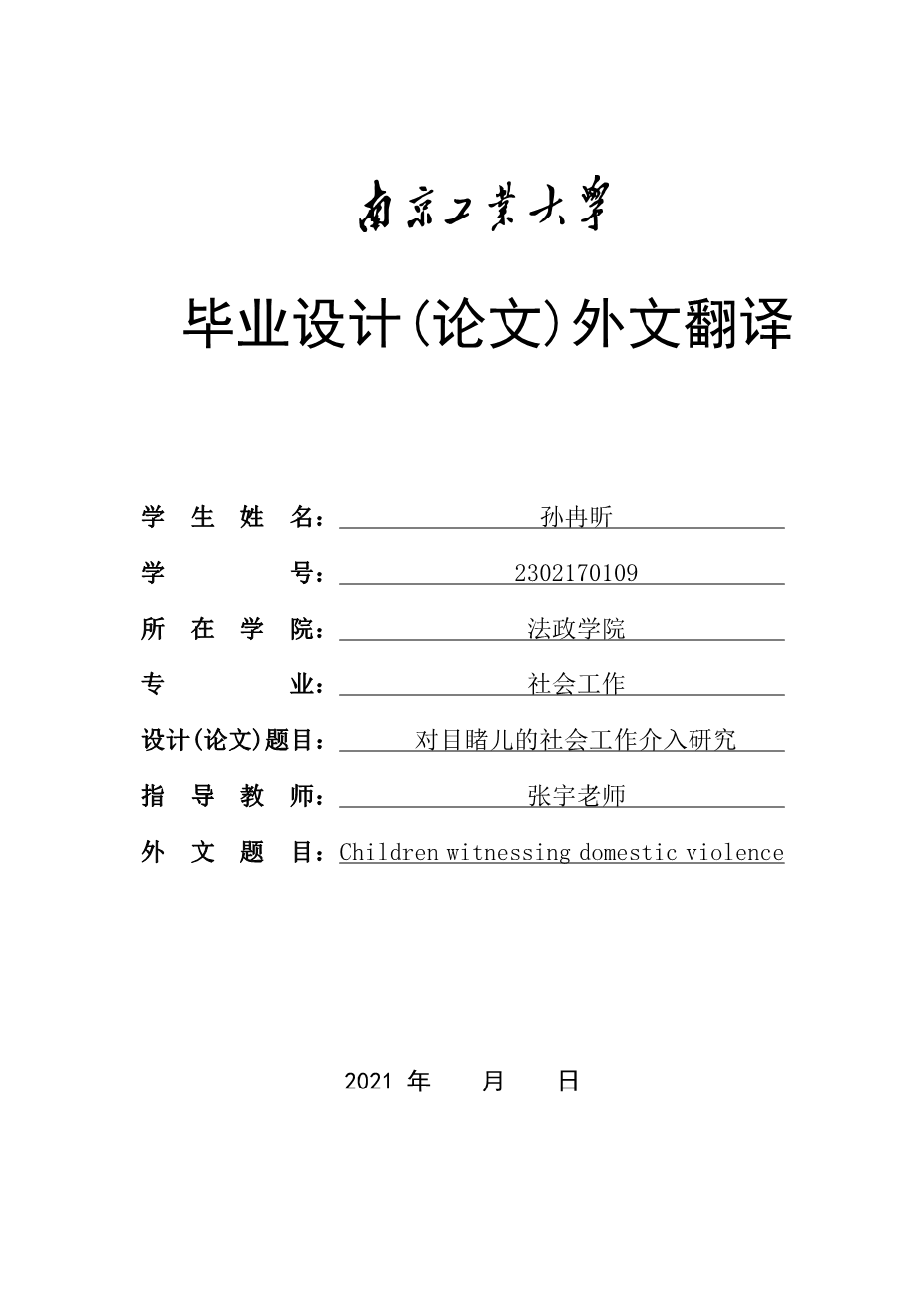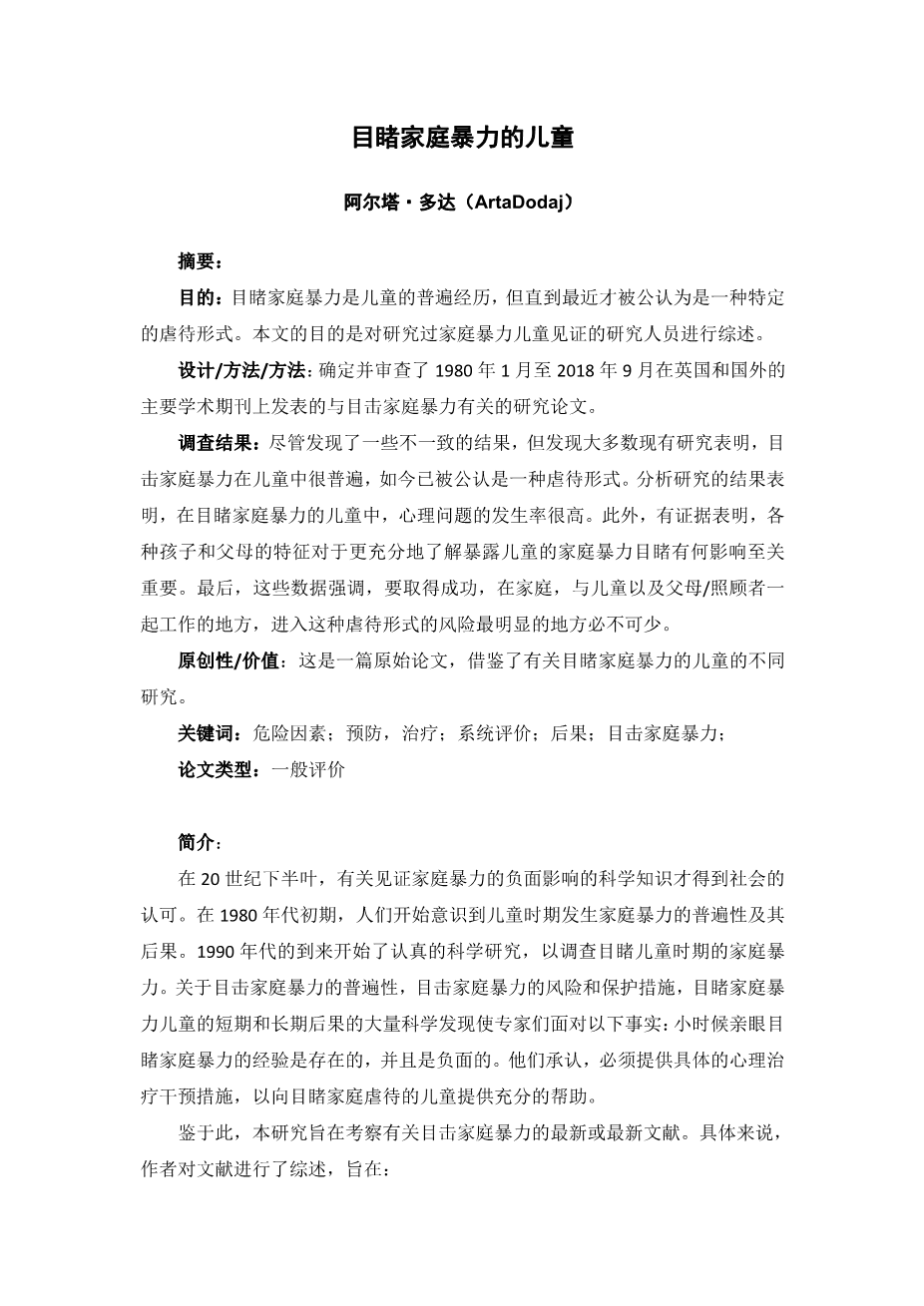Children witnessing domestic violence
Arta Dodaj
Abstract Purpose – Witnessing domestic violence is a common experience among children, but has only recently been recognized as a specific form of abuse. The purpose of this paper is to present a review of the researchers who have examined the experience of children witnessing domestic violence.
Design/methodology/approach – Research papers related to witnessing domestic violence and published in leading academic journals in the UK and abroad from January 1980 to September 2018 were identified and reviewed.
Findings – Although there were some inconsistent findings, it was found that most of the available research suggests that witnessing domestic violence is prevalent among children and recognized today as a form of abuse. Results from analyzed studies identified high rates of psychological problems among children exposed to witnessing domestic violence. Furthermore, there is evidence that a variety of child and parent characteristics are important to more fully understand what influences have on exposure childrenrsquo;s witnessing domestic violence. In the end, this data emphasize that to be successful, access is essential to the places where the risks for the occurrence of this form of abuse is most evident, in the family, working with the child and the parents/caregivers.
Originality/value – This is an original paper which draws on different research about children witnessing domestic violence.
Keywords Risk factors, Prevention, Treatment, Systematic review, Consequences, Witnessing domestic violence
Paper type General review
Introduction
Scientific knowledge about the negative effects of witnessing domestic violence only became available and acknowledged by society in the latter half of the 20th century. In the early 1980s, awareness of the prevalence and the consequences of witnessing domestic violence as a child started to develop. The onset of the 1990s saw the beginning of serious scientific research to investigate witnessing domestic violence in childhood. A large number of scientific findings on the prevalence of witnessing domestic violence, the risk of and protection against witnessing domestic violence, on the short-term and long-term consequences of children witnessing domestic violence have brought experts face to face with the fact that the experience of witnessing domestic violence as a child exists and is negative. They acknowledge that it is essential to provide specific psychotherapeutic interventions to extend adequate help to children who have witnessed domestic abuse.
In view of the above, this study aimed to examine recent or current literature on witnessing domestic violence. Specifically, author undertook a review of the literature aiming to:
- define children witnessing domestic violence;
- assess the prevalence of children witnessing domestic violence;
- identify risk factors and negative consequences of witnessing domestic violence; and
- review treatment and prevention programs in this field.
Arta Dodaj is based at the University of Zadar, Zadar, Croatia.
Received 11 April 2019
Revised 10 September 2019
25 May 2020
7 July 2020
Accepted 8 July 2020
DOI 10.1108/JCS-04-2019-0023 copy; Emerald Publishing Limited, ISSN 1746-6660 jJOURNAL OF CHILDRENrsquo;S SERVICES j
To the best of authors knowledge, only two reviews have been conducted so far which have specifically investigated the literature about witnessing domestic violence. The review conducted by Devaney (2015) focused mostly on the prevalence and impact of domestic violence on children, and interventions directed to those working with children exposed to domestic violence and perpetrators but omitted to provide a comprehensive description of the methodology used. This review will include the vast majority of literature that use systematic and reproducible methods for evaluating the existing body of published research. The most important feature of the current review will be the fuller picture of witnessing domestic violence by its focus on specific-risk factors and prevention programs. A review of the literature by Holt et al. (2008) conducted within an 11-year framework (1995–2006) used comprehensive literature to examine the impact of children and youth witnessing domestic violence on their health and developmental well-being. Although the Holt et al. (2008) review is extensive and methodologically appropriate, it is limited in its scope of assessment because it only included publications which assessed outcomes in four separated domains (domestic violence exposure and child abuse; impact on parental capacity; impact on child and adolescent development; and exposure to additional adversities). This review examines and synthesizes research on other outcome domains, but most importantly, it provides a description of the overall state o
剩余内容已隐藏,支付完成后下载完整资料


英语译文共 14 页,剩余内容已隐藏,支付完成后下载完整资料
资料编号:[266960],资料为PDF文档或Word文档,PDF文档可免费转换为Word
以上是毕业论文外文翻译,课题毕业论文、任务书、文献综述、开题报告、程序设计、图纸设计等资料可联系客服协助查找。
您可能感兴趣的文章
- 晚年丧偶和已婚妇女的休闲活动和抑郁症状外文翻译资料
- 认知行为与心理动力人际治疗对进食障碍的影响:一项关于缓解期患者特征和改变在进食障碍特异性和一般精神病理学中的作用的荟萃分析外文翻译资料
- 社区和疗养院里老年人的精神需要外文翻译资料
- 日本社区协会的参与和正式志愿者外文翻译资料
- 社会工作组织中的变革型领导与社会工作者更替的关系外文翻译资料
- 社区参与现实世界:新形势下的机遇与陷阱治理空间外文翻译资料
- 提升在社区独立生活的长者的生活满意度:看护者对志愿者的看法外文翻译资料
- 非典型就业群体失业保障制度的研究外文翻译资料
- 日本长期护理保险和综合护理外文翻译资料
- 新农合与城镇居民医疗保险并轨研究外文翻译资料


